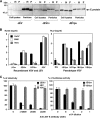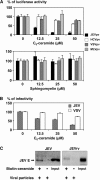Involvement of ceramide in the propagation of Japanese encephalitis virus
- PMID: 20053738
- PMCID: PMC2826033
- DOI: 10.1128/JVI.02499-09
Involvement of ceramide in the propagation of Japanese encephalitis virus
Abstract
Japanese encephalitis virus (JEV) is a mosquito-borne RNA virus and one of the most important flaviviruses in the medical and veterinary fields. Although cholesterol has been shown to participate in both the entry and replication steps of JEV, the mechanisms of infection, including the cellular receptors of JEV, remain largely unknown. To clarify the infection mechanisms of JEV, we generated pseudotype (JEVpv) and recombinant (JEVrv) vesicular stomatitis viruses bearing the JEV envelope protein. Both JEVpv and JEVrv exhibited high infectivity for the target cells, and JEVrv was able to propagate and form foci as did authentic JEV. Anti-JEV envelope antibodies neutralized infection of the viruses. Treatment of cells with inhibitors for vacuolar ATPase and clathrin-mediated endocytosis reduced the infectivity of JEVpv, suggesting that JEVpv enters cells via pH- and clathrin-dependent endocytic pathways. Although treatment of the particles of JEVpv, JEVrv, and JEV with cholesterol drastically reduced the infectivity as previously reported, depletion of cholesterol from the particles by treatment with methyl beta-cyclodextrin enhanced infectivity. Furthermore, treatment of cells with sphingomyelinase (SMase), which hydrolyzes membrane-bound sphingomyelin to ceramide, drastically enhanced infection with JEVpv and propagation of JEVrv, and these enhancements were inhibited by treatment with an SMase inhibitor or C(6)-ceramide. These results suggest that ceramide plays crucial roles in not only entry but also egress processes of JEV, and they should assist in the clarification of JEV propagation and the development of novel therapeutics against diseases caused by infection with flaviviruses.
Figures







Similar articles
-
Rab5 and Rab11 Are Required for Clathrin-Dependent Endocytosis of Japanese Encephalitis Virus in BHK-21 Cells.J Virol. 2017 Sep 12;91(19):e01113-17. doi: 10.1128/JVI.01113-17. Print 2017 Oct 1. J Virol. 2017. PMID: 28724764 Free PMC article.
-
Japanese encephalitis virus infects porcine kidney epithelial PK15 cells via clathrin- and cholesterol-dependent endocytosis.Virol J. 2013 Aug 12;10:258. doi: 10.1186/1743-422X-10-258. Virol J. 2013. PMID: 23937769 Free PMC article.
-
GRP78 Is an Important Host Factor for Japanese Encephalitis Virus Entry and Replication in Mammalian Cells.J Virol. 2017 Feb 28;91(6):e02274-16. doi: 10.1128/JVI.02274-16. Print 2017 Mar 15. J Virol. 2017. PMID: 28053106 Free PMC article.
-
[Research progress in mechanisms of cellular entry of Japanese encephalitis virus].Bing Du Xue Bao. 2014 Mar;30(2):188-92. Bing Du Xue Bao. 2014. PMID: 24923174 Review. Chinese.
-
Virus-host Interactions in Early Japanese Encephalitis Virus Infection.Virus Res. 2023 Jul 2;331:199120. doi: 10.1016/j.virusres.2023.199120. Epub 2023 May 1. Virus Res. 2023. PMID: 37086856 Free PMC article. Review.
Cited by
-
Metalloproteinase-Dependent and TMPRSS2-Independent Cell Surface Entry Pathway of SARS-CoV-2 Requires the Furin Cleavage Site and the S2 Domain of Spike Protein.mBio. 2022 Aug 30;13(4):e0051922. doi: 10.1128/mbio.00519-22. Epub 2022 Jun 16. mBio. 2022. PMID: 35708281 Free PMC article.
-
Flavivirus cell entry and membrane fusion.Viruses. 2011 Feb;3(2):160-171. doi: 10.3390/v3020160. Epub 2011 Feb 22. Viruses. 2011. PMID: 22049308 Free PMC article. Review.
-
Modulation of Lipid Droplet Metabolism-A Potential Target for Therapeutic Intervention in Flaviviridae Infections.Front Microbiol. 2017 Nov 28;8:2286. doi: 10.3389/fmicb.2017.02286. eCollection 2017. Front Microbiol. 2017. PMID: 29234310 Free PMC article. Review.
-
Development and Applications of VSV Vectors Based on Cell Tropism.Front Microbiol. 2012 Jan 18;2:272. doi: 10.3389/fmicb.2011.00272. eCollection 2011. Front Microbiol. 2012. PMID: 22279443 Free PMC article.
-
Analyses of Entry Mechanisms of Novel Emerging Viruses Using Pseudotype VSV System.Trop Med Health. 2014 Jun;42(2 Suppl):71-82. doi: 10.2149/tmh.2014-S10. Trop Med Health. 2014. PMID: 25425954 Free PMC article.
References
-
- Aizaki, H., K. Morikawa, M. Fukasawa, H. Hara, Y. Inoue, H. Tani, K. Saito, M. Nishijima, K. Hanada, Y. Matsuura, M. M. Lai, T. Miyamura, T. Wakita, and T. Suzuki. 2008. Critical role of virion-associated cholesterol and sphingolipid in hepatitis C virus infection. J. Virol. 82:5715-5724. - PMC - PubMed
-
- Bollinger, C. R., V. Teichgraber, and E. Gulbins. 2005. Ceramide-enriched membrane domains. Biochim. Biophys. Acta 1746:284-294. - PubMed
-
- Boonsanay, V., and D. R. Smith. 2007. Entry into and production of the Japanese encephalitis virus from C6/36 cells. Intervirology 50:85-92. - PubMed
-
- Chatterjee, S. 1993. Neutral sphingomyelinase increases the binding, internalization, and degradation of low density lipoproteins and synthesis of cholesteryl ester in cultured human fibroblasts. J. Biol. Chem. 268:3401-3406. - PubMed
Publication types
MeSH terms
Substances
LinkOut - more resources
Full Text Sources
Other Literature Sources

